Articles
- Page Path
- HOME > J Musculoskelet Trauma > Volume 21(2); 2008 > Article
-
Original Article
- Alterations in Serum Levels of Receptor Activator of Nuclear Factor-kappa B Ligand and Osteoprotegerin in Patients with Head Injury and Fracture
- Shin Young Park, Kuen Tak Suh, M.D., Chang Hoon Ryu, M.D., Seung Hun Woo, M.D., Jung Sub Lee, M.D., Seong-Gang Kim
-
Journal of the Korean Fracture Society 2008;21(2):145-150.
DOI: https://doi.org/10.12671/jkfs.2008.21.2.145
Published online: April 30, 2008
Department of Orthopedic Surgery, Pusan National University School of Medicine, Busan, Korea.
*Department of Orthopedic Surgery, Pusan National University School of Medicine, Busan, Korea.
†Department of Nuclear Medicine, Pusan National University School of Medicine, Busan, Korea.
- Address reprint requests to: Jung Sub Lee, M.D. Department of Orthopaedic Surgery, Pusan National University Hospital, 10, Ami-dong 1-ga, Seo-gu, Busan 602-739, Korea. Tel: 82-51-240-7248, Fax: 82-51-247-8395, jungsublee@pusan.ac.kr
Copyright © 2008 The Korean Fracture Society. All rights reserved.
This is an Open Access article distributed under the terms of the Creative Commons Attribution Non-Commercial License (http://creativecommons.org/licenses/by-nc/3.0/) which permits unrestricted non-commercial use, distribution, and reproduction in any medium, provided the original work is properly cited.
- 434 Views
- 3 Download
- 1 Crossref
Abstract
-
Purpose
- Receptor activator of nuclear factor-κB ligand (RANKL), osteoprotegerin (OPG) have been shown to be important regulators of osteoclastogenesis during bone remodeling, and their expressions were examined during fracture healing in a mouse model of tibial fracture. However, studies linking RANKL and OPG in patients with head injury and fracture are lacking. We evaluated the changes in serum levels of RANKL and OPG in patients with head injury and fracture (head injury group) and in patients with fracture (fracture group) and compared these with levels found in healthy control subjects.
-
Materials and Methods
- 18 male patients of head injury and fracture and 20 male patients of fracture alone were enrolled. 20 healthy men were recruited to serve as controls. Within the first few hours of admission to hospital, at 4, 8 and 12 weeks after injury 20 ml of blood were obtained from 18 patients with head injury and fracture and 20 patients with fracture only.
-
Results
- RANKL levels were significantly lower in the head injury group than in the fracture group at 8 and 12 weeks after injury. OPG levels were significantly higher in the head injury group than in the fracture group at 4, 8 and 12 weeks after injury. RANKL/OPG ratios were significantly lower in the head injury group than in the controls immediately after and 4, 8 and 12 weeks after injury, and were significantly lower in the head injury group than in the fracture group at 8 and 12 weeks after injury.
-
Conclusion
- We have shown changes in the profiles of RANKL, OPG and RANKL to OPG ratio. The altered RANKL, OPG and RANKL/OPG ratio in the head injury group lasted longer than in those of the fracture group.
- 1. Beeton CA, Charfield D, Brooks RA, Rushton N. Circulating levels of interleukin-6 and its soluble receptor in patients with head injury and fracture. J Bone Joint Surg Br, 2004;86:912-917.ArticlePDF
- 2. Bidner SM, Rubins IM, Desjardins JV, Zukor DJ, Goltzman D. Evidence for a humoral mechanism for enhanced osteogenesis after head injury. J Bone Joint Surg Am, 1990;72:1144-1149.Article
- 3. Boes M, Kain M, Kakar S, et al. Ostoegenic effects of traumatic brain injury on experimental fracture-healing. J Bone Joint Surg Am, 2006;88:738-743.
- 4. Einhorn TA, Majeska RJ, Rush EB, Levine PM, Horowitz MC. The expression of cytokine activity by fracture callus. J Bone Miner Res, 1995;10:1272-1281.ArticlePDF
- 5. Felver ME, Mezey E, McGuire M, et al. Plasma tumor necrosis factor alpha predicts decreasing long-term survival in severe alcoholic hepatitis. Alcohol Clin Exp Res, 1990;14:255-259.
- 6. Feuerherm AJ, Borset M, Seidel C, et al. Elevated levels of osteoprotegerin (OPG) and hepatocyte growth factor (HGF) in rheumatoid arthritis. Scand J Rheumatol, 2001;30:229-234.Article
- 7. Garland DE, Rothi B, Waters RL. Femoral fractures in head injured adults. Clin Orthop Relat Res, 1982;166:219-225.Article
- 8. Garland DE, Toder L. Fractures of the tibial diaphysis in adults with head injuries. Clin Orthop Relat Res, 1980;150:198-202.
- 9. Haynes DR, Crotti TN, Loric M, Bain GI, Atkins GJ, Findlay DM. Osteoprotegerin and receptor activator of nuclear factor kappaB ligand (RANKL) regulate osteoclast formation by cells in the human rheumatoid arthritic joint. Rheumatology (Oxford), 2001;40:623-630.Article
- 10. Kalabalikis P, Papazogbou K, Gouriotis D, et al. Correlation between serum IL-6 and CRP levels and severity of head injury in children. Intensive Care Med, 1999;25:288-292.ArticlePDF
- 11. Khosla S, Arrighi HM, Melton LJ 3rd, et al. Correlates of osteoprotegerin levels in women and men. Osteoporos Int, 2002;13:394-399.ArticlePDF
- 12. Kimble RB, Bain S, Pacifici R. The functional block of TNF but not IL-6 prevents bone loss in ovariectomized mice. J Bone Miner Res, 1997;12:935-941.
- 13. Kon T, Cho TJ, Aizawa T, et al. Expression of osteoprotegerin, receptor activator of NF-kappaB ligand (osteoprotegerin ligand) and related proinflammatory cytokines during fracture healing. J Bone Miner Res, 2001;16:1004-1014.
- 14. Kurer MH, Khoker MA, Dandona P. Human osteoblast stimulation by sera from paraplegic patients with heterotopic ossification. Paraplegia, 1992;30:165-168.ArticlePDF
- 15. Lacey DL, Timms E, Tan HL, et al. Osteoprotegerin ligand is a cytokine that regulates osteoclast differentiation and activation. Cell, 1998;93:165-176.Article
- 16. Newman RJ, Stone MH, Mukherjee SK. Accelerated fracture union in association with severe head injury. Injury, 1987;18:241-246.
- 17. Ott L, McClain CJ, Gillespie M, Young B. Cytokines and metabolic dysfunction after severe head injury. J Neurotrauma, 1994;11:447-472.Article
- 18. Perkins R, Skirving AP. Callus formation and the rate of healing of femoral fractures in patients with head injuries. J Bone Joint Surg Br, 1987;69:521-524.ArticlePDF
- 19. Renfree KJ, Banovac K, Hornicek FJ, Lebowohl NH, Villanueva PA, Nedd KJ. Evaluation of serum osteoblast mitogenic activity in spinal cord and head injury patients with acute heterotopic ossification. Spine, 1994;19:740-746.Article
- 20. Rogers A, Eastell R. Circulating osteoprotegerin and receptor activator for nuclear factor Kappa B ligand: clinical utility in metabolic bone disease assessment. J Clin Endocrinol Metab, 2005;90:6323-6331.
- 21. Simonet WS, Lacey DL, Dunstan CR, et al. Osteoprotegerin: a novel secreted protein involved in the regulation of bone density. Cell, 1997;89:309-319.Article
- 22. Singhal A, Baker AJ, Hare GM, Reinders FX, Schlichter LC, Moulton RJ. Association between cerebrospinal fluid interleukin-6 concentrations and outcome after severe human traumatic brain injury. J Neurotrauma, 2002;19:929-937.Article
- 23. Sohn HM, Ha SH, Lee JY, Lee YK. Delayed operative treatment of long bone fractures in patients with brain injury. J Korean Fract Soc, 2006;19:157-162.Article
- 24. Spencer RF. The effect of head injury on fracture healing. A quantitative assessment. J Bone Joint Surg Br, 1987;69:525-528.
- 25. Szalay F, Hegedus D, Lakatos PL, et al. High serum osteoprotegerin and low RANKL in primary biliary cirrhosis. J Hepatol, 2003;38:395-400.Article
- 26. Trofimov S, Pantsulaia I, Kobyliansky E, Livshits G. Circulating levels of receptor activator of nuclear factor-kappaB ligand/osteoprotegerin/macrophage-colony stimulating factor in a presumably healthy human population. Eur J Endocrinol, 2004;150:305-311.Article
- 27. Tsur A, Sazbon L, Lotem M. Relationship between muscular tone, movement and periarticular new bone formation in postcoma-unaware (PC-U) patients. Brain Inj, 1996;10:259-262.Article
- 28. Wildburger R, Zarkovic N, Egger G, Petek W, Zarkovic K, Hofer HP. Basic fibroblast growth factor (BFGF) immunoreactivity as a possible link between head injury and impaired bone fracture healing. Bone Miner, 1994;27:183-192.
- 29. Wildburger R, Zarkovic N, Tonkovic G, et al. Post-traumatic hormonal disturbances: prolactin as a link between head injury and enhanced osteogenesis. J Endocrinol Invest, 1998;21:78-86.ArticlePDF
- 30. Yang KH, Choi CH, Cho JH. Stimulation of fracture healing by low-intensity pulsing ultrasound. J Korean Soc Fract, 1998;11:247-253.Article
REFERENCES
Fig. 1
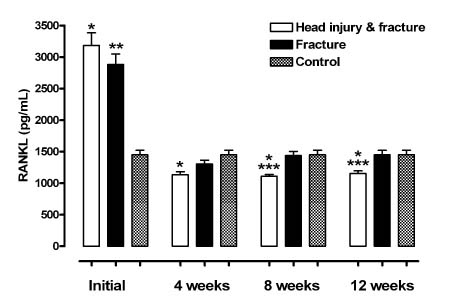
The RANKL levels of the three groups were expressed in terms of the pg/ml immediately after injury, 4, 8 and 12 weeks after injury (statistically significant difference, *; Head injury and fracture group and control group, **; Fracture group and control group, ***; Head injury and fracture group and Fracture group).

Fig. 2
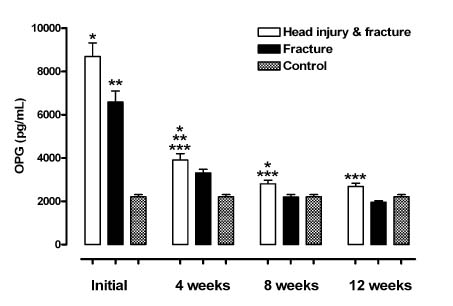
The OPG levels of the three group were expressed in terms of the pg/mL immediately after injury, 4, 8 and 12 weeks after injury (statistically significant difference, *; Head injury and fracture group and control group, **; Fracture group and control group, ***; Head injury and fracture group and Fracture group).

Fig. 3

The RANKL/OPG levels of the three groups were showed immediately after injury, 4, 8 and 12 weeks after injury (statistically significant difference, *; Head injury and fracture group and control group, **; Fracture group and control group, ***; Head injury and fracture group and Fracture group).

Figure & Data
REFERENCES
Citations
Citations to this article as recorded by 

- Affirmative Effect of Hwaweo-jeon (Huayu-jian) in Osteoblast Cells and Tibia Fracture-induced Mice
Soo-Hwan Lee, Kira Parichuk, Yun-yeop Cha
Journal of Korean Medicine Rehabilitation.2020; 30(1): 13. CrossRef
Alterations in Serum Levels of Receptor Activator of Nuclear Factor-kappa B Ligand and Osteoprotegerin in Patients with Head Injury and Fracture


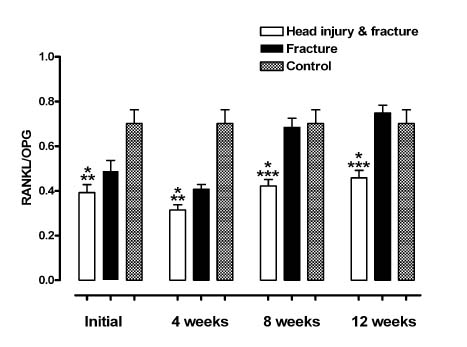
Fig. 1
The RANKL levels of the three groups were expressed in terms of the pg/ml immediately after injury, 4, 8 and 12 weeks after injury (statistically significant difference, *; Head injury and fracture group and control group, **; Fracture group and control group, ***; Head injury and fracture group and Fracture group).
Fig. 2
The OPG levels of the three group were expressed in terms of the pg/mL immediately after injury, 4, 8 and 12 weeks after injury (statistically significant difference, *; Head injury and fracture group and control group, **; Fracture group and control group, ***; Head injury and fracture group and Fracture group).
Fig. 3
The RANKL/OPG levels of the three groups were showed immediately after injury, 4, 8 and 12 weeks after injury (statistically significant difference, *; Head injury and fracture group and control group, **; Fracture group and control group, ***; Head injury and fracture group and Fracture group).
Fig. 1
Fig. 2
Fig. 3
Alterations in Serum Levels of Receptor Activator of Nuclear Factor-kappa B Ligand and Osteoprotegerin in Patients with Head Injury and Fracture
Details of the patients with head injury and fracture
Details of the patients with fracture
Table 1
Details of the patients with head injury and fracture
Table 2
Details of the patients with fracture

 E-submission
E-submission KOTA
KOTA TOTA
TOTA TOTS
TOTS
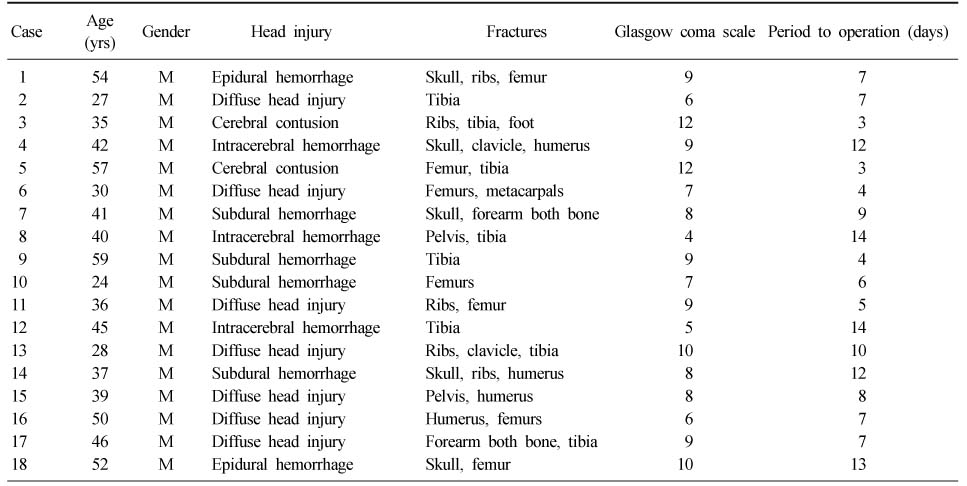
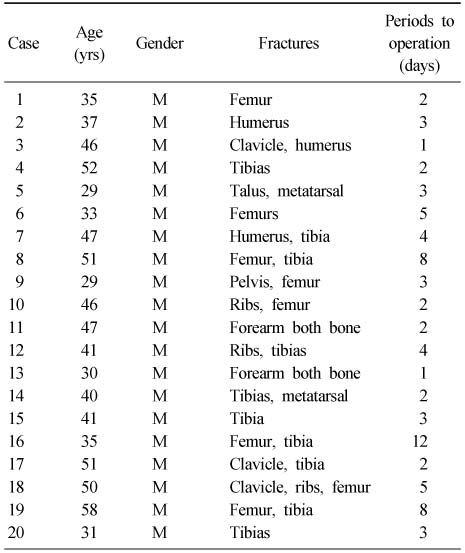
 Cite
Cite

